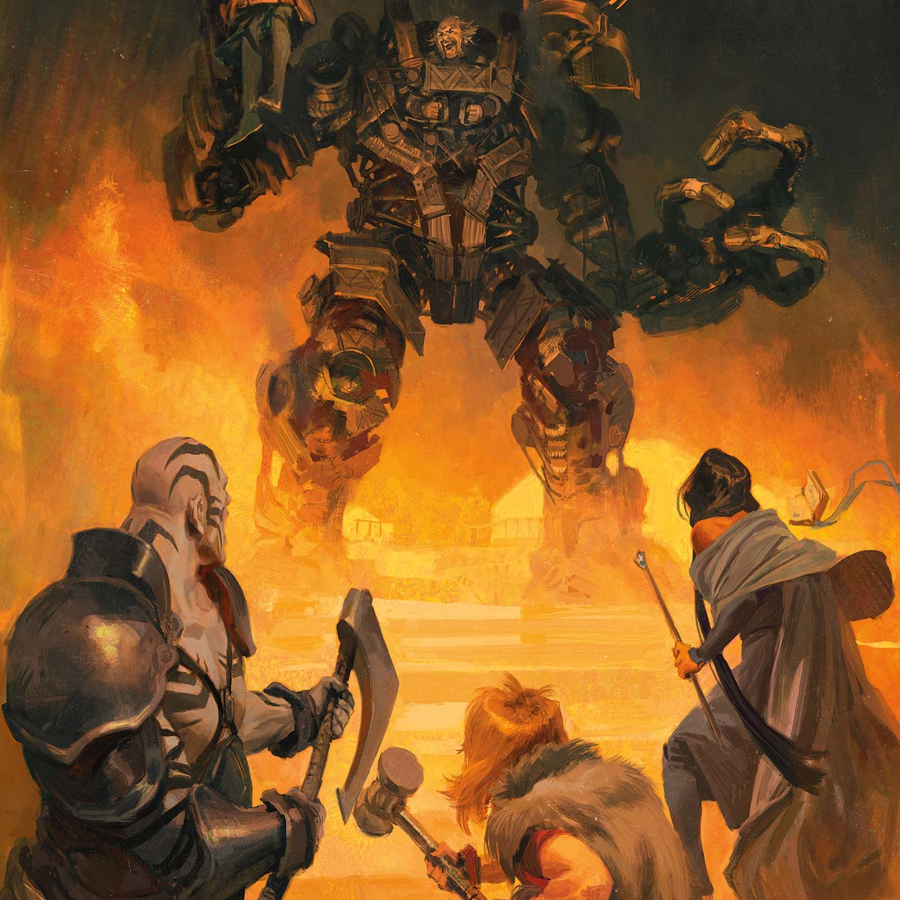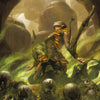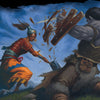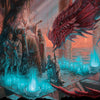How to Create NPCs Your D&D Players Will Actually Care About

Written by Luke Hart
Once, I created an NPC named Thimbledorf Piddenpop, a gnome alchemist. I decided that for this particular NPC, I wanted to create something special that my players would love. So, I put my heart and soul into creating this NPC. It would not be something ordinary or mundane or something my players had interacted with before.
Instead, this NPC would be special; this NPC would be fleshed out in elaborate detail. I would create an entire back story for this NPC with the intention of having it come alive at the game table. To help fuel that, I wanted to create Thimbledorf’s own character sheet—not a base stat block, but a fully fleshed-out character sheet. My theory was that if I spent time crafting this NPC, turning it into something insanely detailed, elaborate, and special, it would be a massive hit at the game table. I thought all of the work, love, blood, sweat, and tears that I put into the NPC would reflect during gameplay.
So, that’s exactly what I did. I put everything I had into creating this NPC. It took me around eight hours or so. It was an entire day’s worth of work for me. That’s a lot of time to spend on an NPC when you have the rest of the adventure to create as well, but I was convinced I would have an NPC my players would adore. So I did it. Thimbledorf had over five pages of back story and a special character sheet.
Then, the game session came up, and it was awesome. We had tons of fun in the adventure; the players were slaying monsters and rescuing prisoners. And then I introduced Thimbledorf Piddenpop.
I was practically giddy with excitement because I had spent so much time working on this NPC, and I was anticipating my players’ glowing reception of Thimbledorf. Of course, you know exactly what happened. It was a yawn fest. My players did not care one bit about my dear gnome alchemist. They were completely indifferent, and my heart was broken—my morale shattered. I went off and cried in a corner.
OK. It wasn’t that bad. I’m a grown adult and generally don’t behave like that. But you get my point. Despite all of my efforts to flesh him out and make him awesome, that NPC fell completely flat at the game table. I learned that the amount of time and effort you put into creating an NPC does not directly correlate with how much your players will care about an NPC.
Ultimately, I learned that the worst NPC I can create is one my players don’t care about, the one they are indifferent to. If my players love an NPC, that’s wonderful. Even if my players hate an NPC, well, shoot, that’s good, too, because they have feelings, and as a game master, I can do something with those feelings. Those feelings serve to motivate my players.
But when there are no feelings, neither love nor hate, I have nothing. My players don’t care at all, and it’s time to move on.
Today, we’re going over NPCs and how to create ones your players will actually care about. After all, these are the only NPCs that really matter in your game. First, we’ll cover some high-level points, which are the lessons I’ve learned and now apply when I make NPCS. Next, I’ll share what important elements apply to all NPCs when creating them. Then we’ll move on to villains, which are arguably some of the most important NPCS you can have in your games. Finally, we’ll wrap up by talking about allies.
By the way, are you a NEW GAME MASTER feeling a bit overwhelmed by everything involved with running a role-playing game? If so, the Secret Art of Game Mastery can help. Get over 100 years of GM experience distilled into practical, easy-to-read advice.
Watch or listen to this article by clicking the video below.
General NPC Guidelines
The first thing I want to go over is some general guidelines that apply to creating almost any type of NPC, whether it is an ally or villain, an NPC that plays a major role in your campaign, or an NPC with a very minor role. These guidelines apply to pretty much everything.
#1 Do not make character sheets for NPCs.
Character sheets were designed for player characters, not for a game master running an NPC. Why? Because a player usually only runs one character, if a character sheet is complex, it’s not that big of a deal since that’s all the player has to do. However, a game master has a lot going on during the game, and running an NPC is just one tiny part of their job. So, if you create a two-to-four-page character sheet to run your NPCs with, it will be way too much work and way more information than you actually need. You’re going to be in a situation of information overload, where there is so much information you end up not using any of it.
Instead, as a game master, you want stat blocks for your NPCs. The only reason to have a character sheet or a stat block is to inform skill checks and to have game mechanics to use if things devolve to combat. A stat block will serve those purposes just fine, and step locks were designed specifically for game masters. They’re succinct and simplified in ways that character sheets just are not. So, when you have to choose your tools, choose those designed for you, the game master.
#2 Do not write elaborate backstories.
You do not need five pages of backstory for an NPC. Creating that much backstory for every NPC will not only take forever, which takes time away from creating other elements, such as the adventure, but I guarantee that much of those backstories never get used. And why is that you might ask?
Well, there are two reasons. First, most NPCs are on screen for very short periods, so there’s only so much backstory information you can even use to inform that NPC’s roleplay. The next reason is simply a matter of usability. If you have five pages of backstory, unless you have an amazing memory, you won’t remember it all. You probably won’t sit during the game session for five minutes trying to look up backstory information because your players will have to sit there and wait, leading to a slow, boring game.
Instead, what you’re going to do is chuck that five-page backstory over your shoulder and make crap up based on what you do remember. So, what I propose is that you save yourself some time. Instead of writing that five-page backstory, write five bullet points of information you can actually use during your game session.
These five bullet points will be very easy for you to skim over during the game. You see, this is a very important game master technique. You want to minimize your prep time in such a way that you maximize your efficiency. In other words, you want to prep what you’ll use and avoid prepping the things you probably never will. That will make your game prep much more efficient, save you time, and result in a game that is just as good, if not better.
I use a template for my games when I design NPCs. It’s the same template we use when we create adventures and NPCs for the products that we publish. We have found that this template helps guide us through creating the most important parts of NPCs, whether they are allies, villains, or just random people the players run into during the game.
This is the same template you can find in The Secret Art of Preparation, the companion book to The Secret Art of Game Mastery. However, if you don’t have that book, that’s fine. I’ll walk you through the template and give examples throughout the rest of this article.
What to Create for All NPCs
#1 Name your NPC.
The first thing every NPC should have is a name. Now, you already know that because if you’ve been a game master for just one game session, you know your players will ask for the name. In fact, if you’ve been a game master for a few game sessions, you’ve probably already been caught with your pants down when you didn’t know the name of some random NPC. This is why I keep a list of random names behind my game master screen.
However, I caution you to fight against the urge to create “fantasy” names. Many times, when we’re writing names for our games, we make them long and fanciful; we make them fantastic. And, of course, we have a certain amount of mandatory fantasy apostrophes that we put into the names.
But there’s a problem with this. You see, Amarashilion Faerlethyon may seem like a cool fantasy name, but it’s not something the PCs will remember. Amara Faer would be much easier.
Furthermore, if your names are too complex, your players will probably give your NPC a pet name. This isn’t really a problem; in fact, I think it’s kind of hilarious. Sometimes, the players come up with pet names that just leave you dying at the game table, right? For instance, the gnome alchemist I mentioned earlier, Thimbledorf Piddenpop, also got a pet name. And can you guess what my wonderful players decided to call him? Pudding pop. That’s right, pudding pop. And I’ll be honest; I thought it was pretty funny. I kinda liked it.
So, you know what I think? Maybe we’re at an impasse. If you like the pet name thing and how your ridiculously complex fantasy names always get truncated into something more usable and fun, then maybe you should create crazy long fantasy names because that’s half the fun of running an NPC. So, you just do what you know will work at your game table.
#2 Select a species, lineage, or ancestry for your NPC.
The game system you’re running will call this something else, but we all know what it means. I suggest that most NPCs have an ancestry native to or near where they live. If your fantasy game is like most, there really aren’t any means of affordable mass transportation, which means most people will spend much of their lives close to home.
The exception to this, of course, is when you have a major metropolitan city such as
Sharn in the Eberron campaign setting. I suppose Eberron isn’t the best example, though, since they do have mass transportation because it is a more technologically advanced game setting. Or maybe, actually, it is. When you travel to the Mror Holds in Eberron, it still has mostly dwarves and a scattering of orcs; you don’t find many elves or halflings there.
That said, an NPC of exotic ancestry is definitely memorable and interesting. However, the game master needs to know why they’re there, possibly how they got there, and why they chose to stay. I’m not saying not to have diverse and interesting NPCs in different locations in your game world. I mean that it needs to make sense in the context of your game world, and it’ll be up to you to make it make sense.
#3 Knowing NPC alignments will help define NPC values.
If your game doesn’t use alignment, you want to define which elements form that NPC’s values. For instance, in Pathfinder 2e, that might mean knowing their edicts and anathemas.
If the game system you’re using has alignment, knowing the NPC’s core alignment can help define that NPC’s values. It also gives you useful information that helps you roleplay that NPC. My only word of caution here is not to allow alignment to hamstring your ability to flesh out the NPCs, nor should alignment be their only defining personality trait.
Asking the following questions during NPC creation can make it more realistic and give it depth. What does the character want? What do they want to accomplish? What is the character afraid of? What causes them concern or anxiety? What does the character like? What do they dislike? What are the limits of what the character will do for the player characters? How can these limits be changed or challenged?
#4 Write a brief physical description of the NPC.
Don’t limit this description to just what they look like; use some of the other senses. What does the character sound like? Do they talk quietly? Are they loud and boisterous? Do they have an accent? Is it a thick accent or a light, barely noticeable one? How do they smell? Are they a meticulous bather who still smells of lye soap? Do they use perfume? Do they smell like they haven’t bathed in a month?
Also, give the NPC a memorable quirk or affectation. Do they always wear a trademark piece of clothing like a hat or a colorful scarf? Do they make constant eye contact or glance around while talking? Do they use their hands a lot when they talk? That’s apparently something I do. . . Maybe they occasionally touch the shoulders of people they talk to? Do they repeat a word or phrase, like calling people “my friend” or ending every other sentence with “you know?”
I want to emphasize that when you write these for your own games, I would write these as bullet points. Be succinct. You don’t need fancy, well-written sentences like we do in our publications. In fact, if you look at The Secret Art of Preparation and go to the NPC template included in that book, you’ll see that we give you one 7x9 page to write information about an NPC. That’s enough room for a few bullet points, not an entire thesis. That’s the point. Be succinct, and only write what you need to run the NPC at your game table.
#5 All NPCS should have a secret.
You want to have a secret because it gives the NPC something really cool that will come out when roleplaying them or be something your players might find out. That can be very rewarding.
I acknowledge right now that giving every NPC an interesting secret can be fairly challenging. However, remembering a few key things can make this easier. First, this doesn’t have to be a dark secret because not everyone has a deep, dark secret. If your NPC has a crush on another NPC, that can be just as interesting. If your players find out about it, that’s information they can use in the game.
Secrets can also tie into future plot points or threads the character can provide to the player characters. Secrets could also be as simple as the NPC keeping a dagger hidden in their boot because they are worried about bandits.
Now, all that said about how secrets can improve gameplay for an NPC, there is a strong likelihood that an NPC’s secret will never come out during gameplay. It may only ever serve to help the game master roleplay the NPC. Therefore, I will submit that most minor NPCs don’t even need a secret. I would save this for key NPCs and those that appear throughout your campaign.
Creating Major Villains
Major villains in your game will need everything we just covered—the things that any NPC needs. However, they also need four additional characteristics.
#1 Major villains need a means.
They need to be able to accomplish the bad things they’re trying to do. If they’re completely powerless and can’t do anything to accomplish their goal, they don’t have a means, and despite their evil intentions, they’re never going to get anywhere. A villain like that is practically worthless because it presents no threat at the game table.
So villains with means might have minions at their disposal, they might have an undead army, or they might be a wealthy merchant who has money that can buy their way toward progressing their goals. But they need to have a means.
Now, part of the means is also the method the villain uses to carry out their nefarious plot. If your villain’s goal is to gain political power or wealth, how will they do that? Do they have great political influence that they can use because they come from a noble family? Or are they a merchant using sleazy business practices to increase their profits? Those would be the methods that they use.
#2 Most interesting villains also consider themselves to be heroes.
The distinguishing factor is how they accomplish their goals, which brings them into conflict with the player characters. For instance, an NPC who wants power but doesn’t break the law or hurt people is not a villain; they’re just an ambitious person with a plan.
A merchant who wants to build wealth but is following the laws and isn’t hurting anybody, and is, in fact, providing lots of jobs to caravan drivers and guards to protect them, and is increasing the commerce in the towns that they trade in, well that merchant isn’t a villain. One might argue that they are providing society with a great service. Sure, they’re making money in exchange for that service, but that doesn’t make them a villain.
#3 Villains need a motive.
They need a reason that drives them to do what they’re trying to do. Why does the villain want to gain political power? Well, it might be because they have grown up seeing the nobility and politicians abusing the people. So they want to effect a change. However, to do so, they are quite willing to break the law and utilize all manner of horrible methods. And why does our merchant want to gather wealth? Perhaps their wife is slowly dying from a horrible illness, and the only way to save her is to finance adventuring parties searching for an ancient artifact that might stop its progression.
This brings up another salient point. A villain might actually have a worthy cause they’re striving to achieve. However, the methods they employ to achieve those goals are what define them as a villain. In that villain’s mind, the end justifies the means, and that is what, in fact, makes them villainous.
In fact, I will argue that the best villains have motivations that are sympathetic or that, at the very least, are understandable to the players. Remember that most villains consider themselves to be doing the right thing.
Anakin Skywalker became Darth Vader because he wanted the power to prevent the deaths of the people he cared about. He also wanted to maintain order in a chaotic Galaxy caught in a pointless war. Magneto from the X-Men wants to end the suffering and persecution of his people because of his experiences with the Holocaust as a child. Skynet was designed to end war and ensure its own ability to maintain peace.
Unfortunately, all of these benevolent intentions came with terrible methods: mass murder, attempts at conquest, and genocide.
And this then brings us to another important point about villains.
#4 Villains usually have what we call a fatal flaw.
This is what prevents them from becoming the heroes they believe themselves to be. This fatal flaw often drives their goals.
For instance, Darth Vader was arrogant and believed himself more capable of achieving his goals than those around him. Magneto allowed his disdain for intolerance to become a prejudice against non-mutants. Skynet lacked compassion for humanity.
Now, if we break down the example of Darth Vader a little more, we will see that he wanted to bring order to a chaotic Galaxy, feared losing his loved ones, liked becoming more powerful, and disliked being told what to do. His fatal flaw of arrogance led him to believe that, as the chosen one, he was better equipped to achieve his goals than others who wanted the same things. This resulted in his goal and desire to eliminate those he saw as failing the Galaxy, which resulted in his succumbing to the power of the dark side and serving the emperor in oppressing the Galaxy to ensure his idea of what order should be.
#5 Major villains need key lieutenants.
These minor villains serve as bosses in key adventures and campaign arcs. Because you see a major villain is likely to be encountered after a series of adventures or perhaps even at the end of your campaign. But each adventure should have its own mini-boss who is a lieutenant or an underling villain of the main villain.
Now, key lieutenants should probably be fleshed out much like major villains, but they don’t need as much detail in all areas.
Remember that lieutenants should make sense for the villain. If the lieutenant working for the main villain doesn’t make sense on the surface, then their motivation should explain this point.
For example, it makes sense for a drow assassin to work for a drow matron mother in the Underdark. However, it may seem odd for a surface elf to be working for that same drow matron mother. However, if that elf wants revenge on their own queen and the matron has promised it to her, then things start coming into focus.
This leads us to another point about lieutenants. They almost always see the major villain as a means to their own ends. If that situation changes, well, that lieutenant may very well change their allegiance. So, understand why the lieutenants work for the major villain, and ask yourself: Is there a way for the player characters to exploit this motivation?
#6 Major villains need minor minions.
These minions serve the major villain and the lieutenants. When we say minions, we’re talking about the run-of-the-mill front-liners the players encounter throughout their adventures. These are the orcs and the orc shamans—the mooks that fill out the ranks.
Now, minions should make sense just like the lieutenants, or they should at least have a reason to work for one or both of them. Remember that since your adventures in a campaign likely span various levels, the means should likewise span a variety of challenge ratings or levels themselves.
Never forget that using the same minions over and over for an entire campaign could very well cause that campaign to become extremely stagnant and downright boring—and not just for your players. Think about yourself as the game master. Wouldn’t you be bored out of your mind if you’re running the exact same minions the entire campaign?
Creating Allies
Let’s move on to creating allies or friendly NPCs. These are the NPCs that are unlikely to oppose the characters and might even help them on their adventures or in other ways.
The first thing you want to know about an ally NPC is their interests. What do they care about? What do they want? What are they afraid of? In many ways, these are some of the same questions we ask when answering questions about their alignment.
This is similar to the motives we would create for a villain, only that for a friendly NPC, the motivations are not pursued in a villainous way. An ally could want power, but they want it for a benevolent reason, and they are working to gain it through legal means that don’t hurt other people.
Ask yourself: What does the NPC do for a living? How do they make money to pay the bills and put food on the table? This should, if at all possible, tie into that NPC’s interests and motivations. Finally, how does their occupation potentially benefit the player characters? When your players run into that NPC, that might become very relevant.
100 Years of GM Experience at Your Fingertips!
Are you a NEW GAME MASTER feeling a bit overwhelmed by everything involved with running a role-playing game? Are you a VETERAN GAME MASTER looking for new tips and tricks to take your games to the next level? Look no further than the Secret Art of Game Mastery.
We at the DM Lair have distilled our CENTURY of accumulated GM experience into an easy-to-read guide of practical advice that you can immediately apply to your games! We've even included our own templates–the things that we use to prepare our ACTUAL games.
Get all three books to master your game:
- The Secret Art of Game Mastery. Contains over 100 years of GM advice distilled into an easy-to-read format. It introduces and explains the tools of the trade, scheduling, playstyle, post-game notes, getting player feedback, and more.
- The Secret Art of Preparation. Brings to your fingertips the actual templates and guides that the DM Lair team uses to prepare games, Lair Magazine, and more. Designed as a three-ring binder, it's intended for you to write directly into for your entire campaign!
- The Secret Art of Notetaking. Gives you the keys to tracking your campaign from session to session just like the DM Lair team. Designed as a three-ring binder, it's intended for you to write in and keep track of your whole campaign!
With so much knowledge and experience on its pages, The Secret Art of Game Mastery is guaranteed to become an indispensable tool for all game masters, new and veteran alike. And if that isn’t enough, the information applies to all game systems and all genres!
-
Posted in
Game Master How-To Articles







